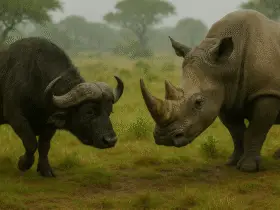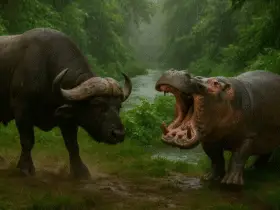In the family of bears there are two insanely powerful creatures who lives in completely different habitats. Polar Bear vs Sloth Bear, What if these two clash? Polar Bear, a snow-covered powerful predator of the Arctic, and the Sloth Bear, a shaggy, fearless powerful bear who lives in Indian subcontinent. Here one is the largest bear on Earth, perfectly adapted to icy waters and mammalian prey, the other is smaller but yet notoriously aggressive, got massive claws and a reputation for standing its ground.
- polar bear (Ursus maritimus)
- sloth bear (Melursus ursinus)
In this crazy battle, Polar Bear vs Sloth Bear, we’ll explore their biology, strengths, and combat potential to answer the ultimate question: who would win?
Hope you will enjoy and learn new features and mind blowing facts about these two beautiful creatures Polar Bear vs Sloth Bear.
1. Body Specifications
| Subtopic | Polar Bear ❄️ | Sloth Bear | Winner |
|---|---|---|---|
| Height (Standing) | 2.4 – 3 meters | 1.5 – 1.9 meters | Polar Bear |
| Length (Nose to Tail) | 2.4 – 3 meters | 1.4 – 1.9 meters | Polar Bear |
| Weight (Male Avg.) | 400 – 600 kg (some up to 1,000 kg) | 80 – 140 kg | Polar Bear |
| Shoulder Height | ~1.6 meters | ~0.9 meters | Polar Bear |
| Skull Size | Up to 40 cm in length | ~30 cm | Polar Bear |
| Bone Density | High (adapted to cold buoyancy) | Moderate | Polar Bear |
| Muscle Mass % | ~50% of body weight | ~35–40% of body weight | Polar Bear |
| Paw Size | Up to 30 cm in width | ~15 cm | Polar Bear |
| Arm Strength | Extremely powerful, used for killing seals | Strong, used for digging and defense | Polar Bear |
| Claw Length | 5–7 cm | Up to 7.5 cm | Sloth Bear |
Topic Winner: Polar Bear
2. Coat and Coloration
| Subtopic | Polar Bear ❄️ | Sloth Bear | Winner |
|---|---|---|---|
| Primary Color | White (camouflage in Arctic) | Black with V-shaped chest patch | Polar Bear |
| Hair Type | Hollow, transparent guard hairs | Long, shaggy outer coat | Sloth Bear |
| Underfur | Dense insulating underfur | Sparse underfur, poor insulation | Polar Bear |
| Melanin Content | Low (adapted for UV reflection) | Higher melanin content for tropical UV | Sloth Bear |
| Seasonal Shedding | Moderate seasonal molt | Minimal seasonal shedding | Polar Bear |
| Insulation Value | Very high (up to -50°C adaptation) | Low (adapted to tropical heat) | Polar Bear |
| Water Resistance | High (oil-rich coat) | Low | Polar Bear |
| Camouflage Efficacy | Excellent in snowy terrain | Poor camouflage | Polar Bear |
| Grooming Behavior | Frequent post-swim grooming | Dust and tree rubbing | Draw |
| Parasite Resistance | Moderate | High (developed for tropical insects) | Sloth Bear |
Topic Winner: Polar Bear
3. Habitat and Range – Polar Bear vs Sloth Bear
| Subtopic | Polar Bear ❄️ | Sloth Bear | Winner |
|---|---|---|---|
| Geographic Range | Arctic Circle (Canada, Greenland, Russia) | Indian subcontinent | Draw |
| Habitat Type | Sea ice, tundra | Forests, grasslands | Draw |
| Elevation Range | Sea level to 1,000 m | Sea level to 1,500 m | Sloth Bear |
| Climate Adaptation | Subzero temperatures | Hot, humid tropical climate | Draw |
| Migration Range | Extensive ice floe travel (100s of km) | Limited mobility | Polar Bear |
| Water Dependency | High (excellent swimmers) | Low | Polar Bear |
| Shelter Preference | Snow dens | Caves, hollows | Draw |
| Habitat Degradation Risk | High (due to melting ice) | High (due to deforestation) | Draw |
| Territorial Size | 150,000+ km² (males) | Up to 13 km² | Polar Bear |
| Human Encroachment | Moderate | High | Polar Bear |
Topic Winner: Polar Bear
4. Diet and Hunting – Polar Bear vs Sloth Bear
| Subtopic | Polar Bear ❄️ | Sloth Bear | Winner |
|---|---|---|---|
| Primary Diet | Carnivorous (mainly seals) | Insectivorous/frugivorous | Polar Bear |
| Hunting Strategy | Ambush at breathing holes | Suction feeding termites | Polar Bear |
| Hunting Success Rate | ~10–20% | ~30–50% (on insects) | Sloth Bear |
| Caloric Intake (Daily) | ~12,000 kcal | ~4,000 kcal | Polar Bear |
| Prey Size | Seals (~100 kg) | Insects/fruit | Polar Bear |
| Bite Efficiency | Precision kill with large canines | Suction feeding with gap in teeth | Draw |
| Dietary Flexibility | Low (mostly carnivorous) | Moderate (fruit, insects, honey) | Sloth Bear |
| Climbing for Food | Poor climber | Excellent climber | Sloth Bear |
| Seasonal Variability | High impact (ice cover dependency) | Moderate (fruiting cycles) | Sloth Bear |
| Scavenging Tendency | Opportunistic scavenger | Rare scavenger | Polar Bear |
Topic Winner: Polar Bear
5. Strength and Bite Force
| Subtopic | Polar Bear ❄️ | Sloth Bear | Winner |
|---|---|---|---|
| Bite Force (PSI) | ~1,200 PSI | ~800 PSI | Polar Bear |
| Forelimb Strength | Exceptional (breaks ice, kills seals) | Strong (digging termites) | Polar Bear |
| Lifting Capacity | ~500+ kg | ~100 kg | Polar Bear |
| Claw Force | Breaks skulls with a swipe | Tears into termite mounds | Polar Bear |
| Wrestling Ability | Powerful grip, often wrestles seals | Agile but not a grappler | Polar Bear |
| Jaw Opening Angle | ~45–50° | ~50° | Draw |
| Muscular Density | Extremely high (cold adaptation) | Moderate | Polar Bear |
| Strike Force | Can kill with a single blow | Can inflict painful slashes | Polar Bear |
| Endurance Strength | High (long-distance swimming) | Medium (foraging, climbing) | Polar Bear |
| Defense Mechanism | Sheer bulk and ferocity | Nocturnal aggression, vocal bluff | Polar Bear |
Topic Winner: Polar Bear
6. Speed and Agility
| Subtopic | Polar Bear ❄️ | Sloth Bear | Winner |
|---|---|---|---|
| Top Speed (Land) | 40 km/h | 40 km/h | Draw |
| Acceleration | Moderate (bulky build) | Rapid bursts (short range) | Sloth Bear |
| Agility (Land) | Limited due to mass | High (quick turns, nimble) | Sloth Bear |
| Climbing Agility | Poor climber | Excellent climber | Sloth Bear |
| Swimming Speed | 9.7 km/h | Weak swimmer | Polar Bear |
| Jumping Ability | Very poor | Moderate (can leap low branches) | Sloth Bear |
| Terrain Maneuverability | Best on ice/snow | Best in forested terrain | Draw |
| Reflex Speed | Moderate | Fast reflexes | Sloth Bear |
| Flexibility | Limited | High flexibility | Sloth Bear |
| Stamina (Chase/Run) | Low (short chases) | Moderate | Sloth Bear |
Topic Winner: Sloth Bear
7. Senses – Polar Bear vs Sloth Bear
| Subtopic | Polar Bear ❄️ | Sloth Bear | Winner |
|---|---|---|---|
| Vision Acuity | Good, especially in low light | Poor (near-sighted) | Polar Bear |
| Hearing Range | Excellent | Good | Polar Bear |
| Smell Sensitivity | Extraordinary (can detect prey 1 km+ away) | Good (used for insects and fruit) | Polar Bear |
| Echolocation | None | None | Draw |
| Night Vision | Adequate | Poor | Polar Bear |
| Daytime Vision | Strong, color perception | Moderate | Polar Bear |
| Sensory Processing | High brain development for smell | High for olfactory too | Draw |
| Ear Mobility | Moderate | Good | Sloth Bear |
| Noise Detection | Good (sensitive to cracks in ice) | High (used at night) | Sloth Bear |
| Olfactory Lobes | Well-developed | Well-developed | Draw |
Topic Winner: Polar Bear
8. Reproduction and Lifespan
| Subtopic | Polar Bear ❄️ | Sloth Bear | Winner |
|---|---|---|---|
| Gestation Period | 195–265 days (delayed implantation) | ~210 days (delayed implantation) | Draw |
| Litter Size | 1–3 cubs | 1–2 cubs | Polar Bear |
| Cub Mortality Rate | High (~60%) | High (~50%) | Sloth Bear |
| Sexual Maturity | 4–6 years | 3–4 years | Sloth Bear |
| Parental Care | 2.5 years of maternal care | 1.5 years (mother carries cubs) | Polar Bear |
| Mating Season | April–May | May–July | Draw |
| Lifespan (Wild) | 20–25 years | 20–25 years | Draw |
| Lifespan (Captivity) | Up to 35 years | Up to 40 years | Sloth Bear |
| Reproductive Frequency | Once every 3 years | Every 2–3 years | Sloth Bear |
| Infanticide Rate | Present (competitive males) | Rare | Sloth Bear |
Topic Winner: Sloth Bear
9. Social Behavior – Polar Bear vs Sloth Bear
| Subtopic | Polar Bear ❄️ | Sloth Bear | Winner |
|---|---|---|---|
| Social Structure | Mostly solitary | Solitary (except mother-cubs) | Draw |
| Territorial Behavior | Yes (males fight for space) | Not strongly territorial | Polar Bear |
| Parental Involvement | High maternal care | High maternal care | Draw |
| Communication Methods | Body language, vocalizations | Grunts, snorts, barks | Draw |
| Aggression Levels | Extremely high (especially males) | High when threatened | Polar Bear |
| Display Behavior | Head swaying, scent marking | Roars, swipes | Draw |
| Cub Carrying Behavior | Walks beside cubs | Carries cubs on back | Sloth Bear |
| Social Tolerance | Low (aggressive to others) | Moderate tolerance | Sloth Bear |
| Conflict Resolution | Dominance displays | Avoidance, roaring | Polar Bear |
| Cooperative Behavior | Rare (except mothers) | None | Draw |
Topic Winner: Draw
10. Conservation Status – Polar Bear vs Sloth Bear
| Subtopic | Polar Bear ❄️ | Sloth Bear | Winner |
|---|---|---|---|
| IUCN Status | Vulnerable | Vulnerable | Draw |
| Population Estimate | ~22,000 – 31,000 | ~20,000 | Polar Bear |
| Population Trend | Decreasing | Decreasing | Draw |
| Major Threats | Climate change, habitat loss | Deforestation, poaching | Draw |
| Legal Protection | CITES Appendix II | CITES Appendix I | Sloth Bear |
| Conservation Programs | Arctic Council, WWF | Project Tiger, Bear Rescue Org. | Draw |
| Protected Range Area | Extensive (Arctic national parks) | Patchy protected forests | Polar Bear |
| Poaching Risk | Low (meat and fur) | High (gallbladders, parts) | Polar Bear |
| Habitat Fragmentation | Yes, due to melting ice | Yes, due to agriculture | Draw |
| Human Conflict Level | Moderate | High | Polar Bear |
Topic Winner: Polar Bear
Face-to-Face Fight: Who Would Win?
In this hypothetical face to face battle between a polar bear vs sloth bear, the results do most in favor of the polar bear. Here’s why:
-
The polar bear outweighs the sloth bear by over 400–800 kg. This gives him a powerful advantage when comes to the strength.
-
Its bite force and claw strength are lethal and adapted for killing seals, preys of polar bears are already very tougher than a sloth bear.
-
Even though the sloth bear has excellent agility and can be fierce, it is biologically built for insect feeding, not combat with apex predators.
-
Even A single swipe from a polar bear could crush bones or deliver fatal trauma.
Fight Winner: Polar Bear
Final Winner – Polar Bear ❄️
Reasons for Victory:
-
Superior strength, size, and weaponry (claws, jaws, muscles).
-
Extreme cold adaptation and efficient energy usage.
-
Exceptional sensory skills (smell and hearing).
-
High combat capability, evolved for predation.
Why the Sloth Bear Loses:
-
Lacks physical mass and brute force.
-
Diet and hunting style unsuited for large-scale combat.
-
Built more for agility and defense than offense.
Interesting Facts
Polar Bear
-
Largest land carnivore, with adult males weighing up to 680 kg.
-
Fur appears white but is actually made of transparent, hollow hairs; skin underneath is black to absorb heat.
-
bigger paws help them walk on ice and swim long distances. (very cute)
-
Can smell seals from over 16 km away. So smelling senses are just mind blowing.
-
Excellent swimmers, able to swim more than 100 km in open water.
-
Rely on sea ice to hunt seals, their main prey.
-
Have a third eyelid to protect their eyes from snow glare.
-
Undergo “walking hibernation” to conserve energy.
-
Thick blubber and fur keep them warm in Arctic temperatures.
-
Highly vulnerable to climate change due to melting sea ice.
Sloth Bear – Interesting Facts
-
Routinely carries cubs on its back for several months.
-
Has a shaggy black coat and a distinct “V” or “Y” mark on the chest.
-
Lacks upper front teeth, making it easier to suck up termites and ants.
-
Can close its nostrils completely while feeding on insects.
-
Mostly nocturnal and known for fierce defense against predators.
-
Uses long, curved claws to dig for insects and climb trees.
-
Eats a diet rich in fruit, honey, termites, and ants.
-
Stands on hind legs and makes loud noises when threatened.
-
Cubs stay with their mother for up to 2.5 years.
-
Inspired the character Baloo in The Jungle Book.
If you enjoyed the Polar Bear vs Sloth Bear battle, Don’t forget to leave a comment! Which creatures do I need to compare next?
References
-
Stirling, I., & Derocher, A. E. (2012). Effects of climate warming on polar bears: a review of the evidence. Global Change Biology.
-
Garshelis, D. L., & Smith, K. G. (1999). Sloth Bear. IUCN Red List of Threatened Species.
-
Nowak, R. M. (1999). Walker’s Mammals of the World. Johns Hopkins University Press.
-
Hilderbrand, G. V., et al. (1999). Role of brown and polar bears in nutrient recycling. Oecologia.
Read More – Polar bear Vs Jaguar – Comprehensive Scientific Comparison






Leave a Reply